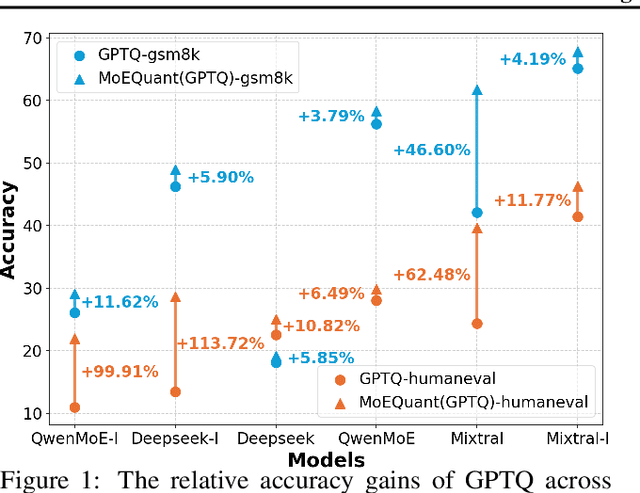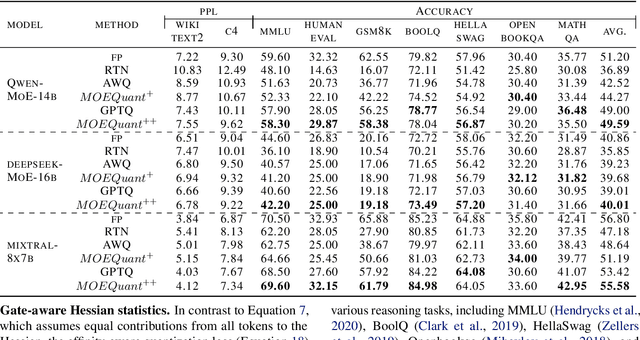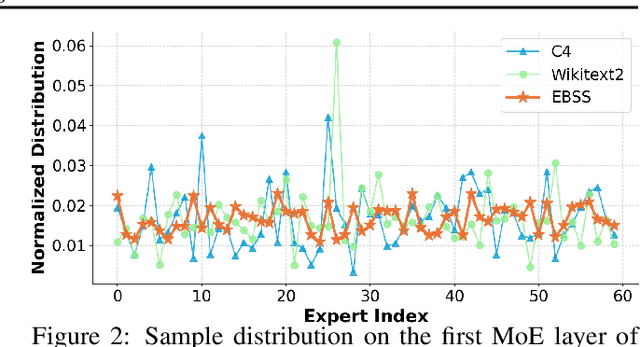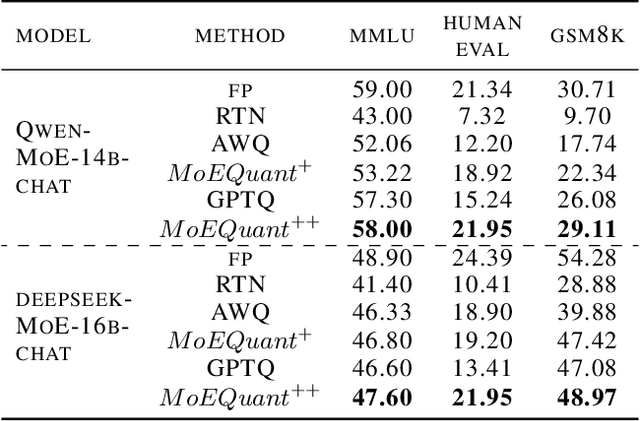Dawei Yang
PCDVQ: Enhancing Vector Quantization for Large Language Models via Polar Coordinate Decoupling
Jun 05, 2025Abstract:Large Language Models (LLMs) face significant challenges in edge deployment due to their massive parameter scale. Vector Quantization (VQ), a clustering-based quantization method, serves as a prevalent solution to this issue for its extremely low-bit (even at 2-bit) and considerable accuracy. Since a vector is a quantity in mathematics and physics that has both direction and magnitude, existing VQ works typically quantize them in a coupled manner. However, we find that direction exhibits significantly greater sensitivity to quantization compared to the magnitude. For instance, when separately clustering the directions and magnitudes of weight vectors in LLaMA-2-7B, the accuracy drop of zero-shot tasks are 46.5\% and 2.3\%, respectively. This gap even increases with the reduction of clustering centers. Further, Euclidean distance, a common metric to access vector similarities in current VQ works, places greater emphasis on reducing the magnitude error. This property is contrary to the above finding, unavoidably leading to larger quantization errors. To these ends, this paper proposes Polar Coordinate Decoupled Vector Quantization (PCDVQ), an effective and efficient VQ framework consisting of two key modules: 1) Polar Coordinate Decoupling (PCD), which transforms vectors into their polar coordinate representations and perform independent quantization of the direction and magnitude parameters.2) Distribution Aligned Codebook Construction (DACC), which optimizes the direction and magnitude codebooks in accordance with the source distribution. Experimental results show that PCDVQ outperforms baseline methods at 2-bit level by at least 1.5\% zero-shot accuracy, establishing a novel paradigm for accurate and highly compressed LLMs.
RWKVQuant: Quantizing the RWKV Family with Proxy Guided Hybrid of Scalar and Vector Quantization
May 02, 2025Abstract:RWKV is a modern RNN architecture with comparable performance to Transformer, but still faces challenges when deployed to resource-constrained devices. Post Training Quantization (PTQ), which is a an essential technique to reduce model size and inference latency, has been widely used in Transformer models. However, it suffers significant degradation of performance when applied to RWKV. This paper investigates and identifies two key constraints inherent in the properties of RWKV: (1) Non-linear operators hinder the parameter-fusion of both smooth- and rotation-based quantization, introducing extra computation overhead. (2) The larger amount of uniformly distributed weights poses challenges for cluster-based quantization, leading to reduced accuracy. To this end, we propose RWKVQuant, a PTQ framework tailored for RWKV models, consisting of two novel techniques: (1) a coarse-to-fine proxy capable of adaptively selecting different quantization approaches by assessing the uniformity and identifying outliers in the weights, and (2) a codebook optimization algorithm that enhances the performance of cluster-based quantization methods for element-wise multiplication in RWKV. Experiments show that RWKVQuant can quantize RWKV-6-14B into about 3-bit with less than 1% accuracy loss and 2.14x speed up.
MoEQuant: Enhancing Quantization for Mixture-of-Experts Large Language Models via Expert-Balanced Sampling and Affinity Guidance
May 02, 2025



Abstract:Mixture-of-Experts (MoE) large language models (LLMs), which leverage dynamic routing and sparse activation to enhance efficiency and scalability, have achieved higher performance while reducing computational costs. However, these models face significant memory overheads, limiting their practical deployment and broader adoption. Post-training quantization (PTQ), a widely used method for compressing LLMs, encounters severe accuracy degradation and diminished generalization performance when applied to MoE models. This paper investigates the impact of MoE's sparse and dynamic characteristics on quantization and identifies two primary challenges: (1) Inter-expert imbalance, referring to the uneven distribution of samples across experts, which leads to insufficient and biased calibration for less frequently utilized experts; (2) Intra-expert imbalance, arising from MoE's unique aggregation mechanism, which leads to varying degrees of correlation between different samples and their assigned experts. To address these challenges, we propose MoEQuant, a novel quantization framework tailored for MoE LLMs. MoE-Quant includes two novel techniques: 1) Expert-Balanced Self-Sampling (EBSS) is an efficient sampling method that efficiently constructs a calibration set with balanced expert distributions by leveraging the cumulative probabilities of tokens and expert balance metrics as guiding factors. 2) Affinity-Guided Quantization (AGQ), which incorporates affinities between experts and samples into the quantization process, thereby accurately assessing the impact of individual samples on different experts within the MoE layer. Experiments demonstrate that MoEQuant achieves substantial performance gains (more than 10 points accuracy gain in the HumanEval for DeepSeekMoE-16B under 4-bit quantization) and boosts efficiency.
A graph neural network-based multispectral-view learning model for diabetic macular ischemia detection from color fundus photographs
Feb 25, 2025Abstract:Diabetic macular ischemia (DMI), marked by the loss of retinal capillaries in the macular area, contributes to vision impairment in patients with diabetes. Although color fundus photographs (CFPs), combined with artificial intelligence (AI), have been extensively applied in detecting various eye diseases, including diabetic retinopathy (DR), their applications in detecting DMI remain unexplored, partly due to skepticism among ophthalmologists regarding its feasibility. In this study, we propose a graph neural network-based multispectral view learning (GNN-MSVL) model designed to detect DMI from CFPs. The model leverages higher spectral resolution to capture subtle changes in fundus reflectance caused by ischemic tissue, enhancing sensitivity to DMI-related features. The proposed approach begins with computational multispectral imaging (CMI) to reconstruct 24-wavelength multispectral fundus images from CFPs. ResNeXt101 is employed as the backbone for multi-view learning to extract features from the reconstructed images. Additionally, a GNN with a customized jumper connection strategy is designed to enhance cross-spectral relationships, facilitating comprehensive and efficient multispectral view learning. The study included a total of 1,078 macula-centered CFPs from 1,078 eyes of 592 patients with diabetes, of which 530 CFPs from 530 eyes of 300 patients were diagnosed with DMI. The model achieved an accuracy of 84.7 percent and an area under the receiver operating characteristic curve (AUROC) of 0.900 (95 percent CI: 0.852-0.937) on eye-level, outperforming both the baseline model trained from CFPs and human experts (p-values less than 0.01). These findings suggest that AI-based CFP analysis holds promise for detecting DMI, contributing to its early and low-cost screening.
Q-PETR: Quant-aware Position Embedding Transformation for Multi-View 3D Object Detection
Feb 21, 2025Abstract:PETR-based methods have dominated benchmarks in 3D perception and are increasingly becoming a key component in modern autonomous driving systems. However, their quantization performance significantly degrades when INT8 inference is required, with a degradation of 58.2% in mAP and 36.9% in NDS on the NuScenes dataset. To address this issue, we propose a quantization-aware position embedding transformation for multi-view 3D object detection, termed Q-PETR. Q-PETR offers a quantizationfriendly and deployment-friendly architecture while preserving the original performance of PETR. It substantially narrows the accuracy gap between INT8 and FP32 inference for PETR-series methods. Without bells and whistles, our approach reduces the mAP and NDS drop to within 1% under standard 8-bit per-tensor post-training quantization. Furthermore, our method exceeds the performance of the original PETR in terms of floating-point precision. Extensive experiments across a variety of PETR-series models demonstrate its broad generalization.
NVR: Vector Runahead on NPUs for Sparse Memory Access
Feb 19, 2025Abstract:Deep Neural Networks are increasingly leveraging sparsity to reduce the scaling up of model parameter size. However, reducing wall-clock time through sparsity and pruning remains challenging due to irregular memory access patterns, leading to frequent cache misses. In this paper, we present NPU Vector Runahead (NVR), a prefetching mechanism tailored for NPUs to address cache miss problems in sparse DNN workloads. Rather than optimising memory patterns with high overhead and poor portability, NVR adapts runahead execution to the unique architecture of NPUs. NVR provides a general micro-architectural solution for sparse DNN workloads without requiring compiler or algorithmic support, operating as a decoupled, speculative, lightweight hardware sub-thread alongside the NPU, with minimal hardware overhead (under 5%). NVR achieves an average 90% reduction in cache misses compared to SOTA prefetching in general-purpose processors, delivering 4x average speedup on sparse workloads versus NPUs without prefetching. Moreover, we investigate the advantages of incorporating a small cache (16KB) into the NPU combined with NVR. Our evaluation shows that expanding this modest cache delivers 5x higher performance benefits than increasing the L2 cache size by the same amount.
GSQ-Tuning: Group-Shared Exponents Integer in Fully Quantized Training for LLMs On-Device Fine-tuning
Feb 18, 2025Abstract:Large Language Models (LLMs) fine-tuning technologies have achieved remarkable results. However, traditional LLM fine-tuning approaches face significant challenges: they require large Floating Point (FP) computation, raising privacy concerns when handling sensitive data, and are impractical for resource-constrained edge devices. While Parameter-Efficient Fine-Tuning (PEFT) techniques reduce trainable parameters, their reliance on floating-point arithmetic creates fundamental incompatibilities with edge hardware. In this work, we introduce a novel framework for on-device LLM fine-tuning that eliminates the need for floating-point operations in both inference and training, named GSQ-Tuning. At its core is the Group-Shared Exponents Integer format, which efficiently represents model parameters in integer format using shared exponents among parameter groups. When combined with LoRA-like adapters, this enables fully integer-based fine-tuning that is both memory and compute efficient. We demonstrate that our approach achieves accuracy comparable to FP16-based fine-tuning while significantly reducing memory usage (50%). Moreover, compared to FP8, our method can reduce 5x power consumption and 11x chip area with same performance, making large-scale model adaptation feasible on edge devices.
Is an Ultra Large Natural Image-Based Foundation Model Superior to a Retina-Specific Model for Detecting Ocular and Systemic Diseases?
Feb 10, 2025Abstract:The advent of foundation models (FMs) is transforming medical domain. In ophthalmology, RETFound, a retina-specific FM pre-trained sequentially on 1.4 million natural images and 1.6 million retinal images, has demonstrated high adaptability across clinical applications. Conversely, DINOv2, a general-purpose vision FM pre-trained on 142 million natural images, has shown promise in non-medical domains. However, its applicability to clinical tasks remains underexplored. To address this, we conducted head-to-head evaluations by fine-tuning RETFound and three DINOv2 models (large, base, small) for ocular disease detection and systemic disease prediction tasks, across eight standardized open-source ocular datasets, as well as the Moorfields AlzEye and the UK Biobank datasets. DINOv2-large model outperformed RETFound in detecting diabetic retinopathy (AUROC=0.850-0.952 vs 0.823-0.944, across three datasets, all P<=0.007) and multi-class eye diseases (AUROC=0.892 vs. 0.846, P<0.001). In glaucoma, DINOv2-base model outperformed RETFound (AUROC=0.958 vs 0.940, P<0.001). Conversely, RETFound achieved superior performance over all DINOv2 models in predicting heart failure, myocardial infarction, and ischaemic stroke (AUROC=0.732-0.796 vs 0.663-0.771, all P<0.001). These trends persisted even with 10% of the fine-tuning data. These findings showcase the distinct scenarios where general-purpose and domain-specific FMs excel, highlighting the importance of aligning FM selection with task-specific requirements to optimise clinical performance.
GSRender: Deduplicated Occupancy Prediction via Weakly Supervised 3D Gaussian Splatting
Dec 19, 2024



Abstract:3D occupancy perception is gaining increasing attention due to its capability to offer detailed and precise environment representations. Previous weakly-supervised NeRF methods balance efficiency and accuracy, with mIoU varying by 5-10 points due to sampling count along camera rays. Recently, real-time Gaussian splatting has gained widespread popularity in 3D reconstruction, and the occupancy prediction task can also be viewed as a reconstruction task. Consequently, we propose GSRender, which naturally employs 3D Gaussian Splatting for occupancy prediction, simplifying the sampling process. In addition, the limitations of 2D supervision result in duplicate predictions along the same camera ray. We implemented the Ray Compensation (RC) module, which mitigates this issue by compensating for features from adjacent frames. Finally, we redesigned the loss to eliminate the impact of dynamic objects from adjacent frames. Extensive experiments demonstrate that our approach achieves SOTA (state-of-the-art) results in RayIoU (+6.0), while narrowing the gap with 3D supervision methods. Our code will be released soon.
Panoptic-FlashOcc: An Efficient Baseline to Marry Semantic Occupancy with Panoptic via Instance Center
Jun 15, 2024Abstract:Panoptic occupancy poses a novel challenge by aiming to integrate instance occupancy and semantic occupancy within a unified framework. However, there is still a lack of efficient solutions for panoptic occupancy. In this paper, we propose Panoptic-FlashOcc, a straightforward yet robust 2D feature framework that enables realtime panoptic occupancy. Building upon the lightweight design of FlashOcc, our approach simultaneously learns semantic occupancy and class-aware instance clustering in a single network, these outputs are jointly incorporated through panoptic occupancy procession for panoptic occupancy. This approach effectively addresses the drawbacks of high memory and computation requirements associated with three-dimensional voxel-level representations. With its straightforward and efficient design that facilitates easy deployment, Panoptic-FlashOcc demonstrates remarkable achievements in panoptic occupancy prediction. On the Occ3D-nuScenes benchmark, it achieves exceptional performance, with 38.5 RayIoU and 29.1 mIoU for semantic occupancy, operating at a rapid speed of 43.9 FPS. Furthermore, it attains a notable score of 16.0 RayPQ for panoptic occupancy, accompanied by a fast inference speed of 30.2 FPS. These results surpass the performance of existing methodologies in terms of both speed and accuracy. The source code and trained models can be found at the following github repository: https://github.com/Yzichen/FlashOCC.
 Add to Chrome
Add to Chrome Add to Firefox
Add to Firefox Add to Edge
Add to Edge